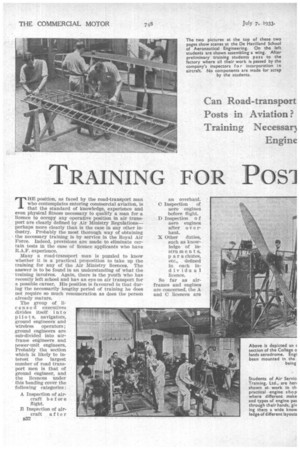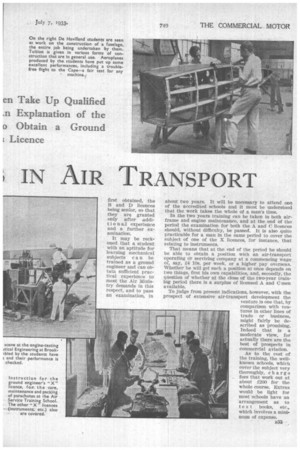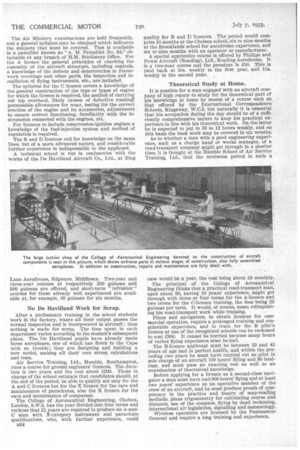y r
Page 50

Page 51

Page 52

If you've noticed an error in this article please click here to report it so we can fix it.
AINING FO
Posi
IN AIR ANSPO
THE position, as faced by the road-transport man who contemplates entering commercial aviation, is that the standard of knowledge, experience and even physical fitness necessary to qualify a man for a licence to occupy any operative position in air transport are clearly defined by Air Ministry Regulations— perhaps more clearly than is the case in any other industry. Probably the most thorough way of obtaining the necessary training is by service in the Royal Air Force. Indeed, provisions are made to eliminate certain tests in the case of licence applicants who have R.A.F. experience.
Many a road-transport man is puzzled to know whether it is a practical proposition to take up the training for any of the Air Ministry licences. The answer is to be found in an understanding of what the training involves. Again, there is the youth who has recently left school and has an eye on air transport for a possible career. His position is favoured in that during the necessarily lengthy period of training he does not require so much remuneration as does the person already mature.
The group of licensed executives divides itself in t 0 pilot s, navigators, ground engineers and wireless operators; ground engineers are subdivided into airframe engineers and power-unit engineers. Probably the section which is likely to interest the largest number of road transport men is that of ground engineer, and the licences under this heading cover the following categories :
A Inspection of aircraft before flight.
n Inspection of aircraft after B32 an overhaul.
C Inspection of aero engines before flight.
D Inspection o f aero engines after o v e rhaul.
X Other duties, such as knowledge of instru men t s, p ar a chutes, etc., defined in each individual licence.
So far as airframes and engines are concerned, the A and C licences are first obtained, the B and D licences being senior, so that they are granted only after addition ad experience and a further examination.
It may be reekoned that a student with an aptitude for learning mechanical subjects can be trained as a ground engineer and can obtain sufficient practical experience to meet the Air Ministry demands in this respect, and to pass an examination, in about two years. It will be necessary to attend one of the accredited schools and it must be understood that the work takes the whole of a man's time.
In the two years training can be taken in both airframe and engine maintenance, and at the end of the period the examination for both the A and C licences should, without difficulty, be passed. It is also quite practicable for a man in the same period to cover the subject of one of the X licences, for instance, that relating to instruments.
That means that at the end of the period he should be able to obtain a position with an air-transport operating or servicing company at a commencing wage of, say, 10s. per week, or a higher pay overseas. Whether he will get such a position at once depends on two things, first his own capabilities, and, secondly, the question of whether at the close of the two-year training period there is a surplus of licensed A and C men available.
To judge from present indications, however, with the prospect of extensive air-transport development the venture is one that, by comparison with ventures in other lines of trade or business, might fairly be described as promising. Indeed that is a moderate view, for actually there are the best of prospects in commercial aviation.
As to the cost of the training, the wellknown schools, which cover the subject very thoroughly, charge fees that work out at about £200 for the whole course. Extras would be light for most schools have an arrangement as to text books, etc., which involves a minimum of expense. The Air Ministry examinations are held frequently, and a general syllabus may be obtained which indicates the subjects that must be covered. This is available in a pamphlet known as "A. M. Pamphlet No. 34," obtainable at any branch of H.M. Stationery Office. For the A licence the general principles of checking the assembly of the aircraft structure, including controls, a knowledge of the defects and deterioration in framework coverings and other parts, the inspection and installation of flying instruments, etc., are included.
The syllabus for the C licence covers a knowledge of the general construction of the type or types of engine for which the licence is required, the method of carrying out top overhaul, likely causes of defective runnine permissible allowances for wear, testing for the correct erection of the engine and its accessories, adjustments to ensure correct functioning, familiarity with the instruments connected with the engines, etc.
For licences to include compression-ignition engines a knowledge of the fuel-injection system and method of regulation is required.
The B and D licences call for knowledge on the same lines, but of a more advanced nature, and considerable further experience is indispensable to the applicant.
A technical school is run in conjunction with the works of the De Havilland Aircraft Co., Ltd., at Stag Lane Aerodrome, Edgware, Middlesex. Two-year and three-year courses at respectively 200 guineas and BOO guineas are offered, and short-term " refresher " courses for those already well experienced are available at, for example, 00 guineas for six months.
No De Havilland Work for Scrap.
After a preliminary training in the school students work in the factory, where all their output passes the normal inspection and is incorporated in aircraft ; thus nothing is made for scrap. The time spent in each department varies according to the student's subsequent plans. The De Havilland pupils have already made three aeroplanes, one of which has flown to the Cape with no trouble ; they are designing and building a new model, making all their own stress calculations and tests.
Air Service Training, Ltd., Hamble, Southampton, runs a course for ground engineers' licences. The duration is two years and the cost about £200. Those in charge of the school estimate that candidates should, at the end of the period, be able to qualify not only for the A and C licences but for the X licence for the care and maintenance of parachutes, also the X licence for the care and maintenance of compasses.
The College of Aeronautical Engineering, Chelsea, London, S.W.3, has the year divided into four terms and reckons that 21 years are required to produce an A-andC man with X-category instrument and parachute qualifications, who, with further experience, could 1334 quality for B and D licences. The period would comprise 15 months at the Chelsea school, six to nine months at the Brooklands school for aerodrome experience, and six to nine months with an operator or manufacturer.
A special apprentice course is offered by Phillips and Powis Aircraft (Reading), Ltd., Reading Aerodrome. It is a two-year course and the premium is £50. This is paid back at 10s. weekly in the first year, and 15s. weekly in the second year.
Theoretical Study at Home.
It is possible for a man engaged with an aircraft company of high repute to study for the theoretical part of his knowledge at home by means of a course such as that offered by the International Correspondence Schools, Kingsway, W.C2, but naturally it is essential that his occupation during the day should be of a sufficiently comprehensive nature to keep his practical experience in line with his theoretical work. On the latter he is expected to put in 10 to 12 hours weekly, and on this basis the book work may be covered in six months.
As to whether a man with a good engineering experience, such as a charge hand or works manager, of a road-transport company might get through in a shorter time, it is thought at the Hamble School of Air Service Training, Ltd., that the minimum period in such a case would be a year, the cost being about 19 monthly.
The principal of the College of Aeronautical Engineering thinks that a practical road-transport man, aged about 30, having 10 years' experience, might get through with three or four terms for the A-licence and two terms for the C-licence training, the fees being 25 guineas per term. It would, of course, mean relinquishing his road-transport work while training.
Pilots and navigators, to obtain licences for commercial operation, require a prolonged training and considerable experience, and to train for the B pilot's licence at one of the recognized schools can be reckoned to cost 1300. It cannot be hurried because many hours of varied flying experience must be had.
The B-licence applicant must be between 19 and 45 years of age and in perfect health, and within the preceding two years he must have carried out as pilot in sole charge of an aircraft 100 hours' flying and 30 landings, and must pass an exacting test as well as an examination of theoretical knowledge.
Before applying for a licence as a second-class navigator a man must have had 300 hours' flying and at least two years' experience as an operative member of the crew of an aircraft, and he must produce proofs of competency in the practice and theory of map-reading methods, plane trigonometry for calculating course and distance, use of the compass, flying by dead reckoning, international air legislation, signalling and meteorology.
Wireless operators are licensed by the Postmaster General and require a long training and experience.




































































































